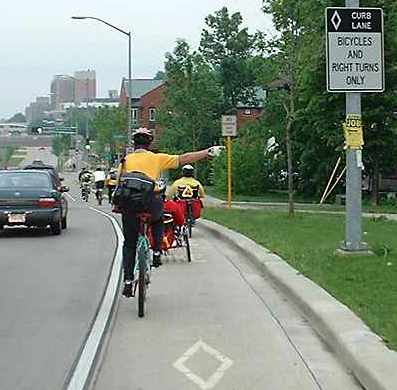
[Table of Contents]
[Previous: Snowed under]
[Next: One way? No way!]
| Traffic law in the USA requires vehicles to merge right before turning right, even
when the rightmost lane is a restricted-used lane such as a parking lane, bike lane or bus
lane. The sign in the picture below, in Madison, Wisconsin, is consistent with this requirement of law. |
The sign shown in the photo below, in Madison, Wisconsin,
USA,
is consistent with law requiring vehicles to merge right
before turning right.

Massachusetts law states this requirement as follows:
Though proponents of the Vassar Street project frequently refer to Dutch standards, this is also the law in the Netherlands. Here are a quote and graphic from a Web page about Dutch traffic law addressed to motorists:
Three safe and legal options for bicyclistsThe motorist must merge to the right, but the bicyclist has three legal and reasonably safe options when traveling straight through an intersection, depending on traffic conditions and the bicyclist's level of skill:
Cambridge's disagreementWhen I [John S. Allen] served on the Cambridge Bicycle Committee (1994-1996), Cambridge Bicycle Coordinator Cara Seiderman repeatedly referred to motor vehicles' yielding when crossing bike lanes, rather than when merging into them, as required by law. Some Bicycle Committee members objected, Seiderman relented, and early Cambridge bike lane installations had dashed sections before intersections. But more recently, Cambridge has installed bike lanes with solid stripes all the way up to the crosswalk. And now, the Vassar Street installation includes signs specifically instructing motorists to turn right from the left lane. Placing through-traveling bicyclists to the right of right-turning motor traffic is typically justified as a way of reducing the demands on bicyclists, so even small children can get around by bicycle. Unfortunately, motorists are then required to look back and to the right, at the same time they need to scan ahead for traffic in the intersection -- an impractical and sometimes impossible burden. The motorist in this scenario can have difficulty seeing the bicyclist for many innocent reasons:
Turning right from the left lane is hazardous. So is entering an intersection from concealment to the right of stopped vehicles. Some problems are shown in the left picture below, from my Bicycling Street Smarts booklet.
Gullible bicyclists are given a false sense of security by the incorrect signs and markings. The problem may be resolved lawfully by providing a separate traffic signal phase for bicyclists -- but at the cost of a substantial increase in waiting time for everyone, leading to a disrespect for the law. A special signal phase might sometimes be justified at a path-road crossing, but not at a low-speed, road-road intersection which is already signalized. The insurrection on Vassar StreetSo, Cambridge and MIT have instructed motorists and bicyclists In the photo below, the red arrow at the lower right corner points to this sign. For the first half of the distance from the sign to the intersection, bicyclists and motorists are hidden from each other by a row of parked cars. Then for half of the remaining distance to the intersection, bicyclists are prevented from entering the roadway. Too little distance remains before the intersection for bicyclists comfortably to negotiate a merge to the left turn lane (yellow arrow) to turn left. Notice the truck turning right from the left side of the bike lane (green arrow). |
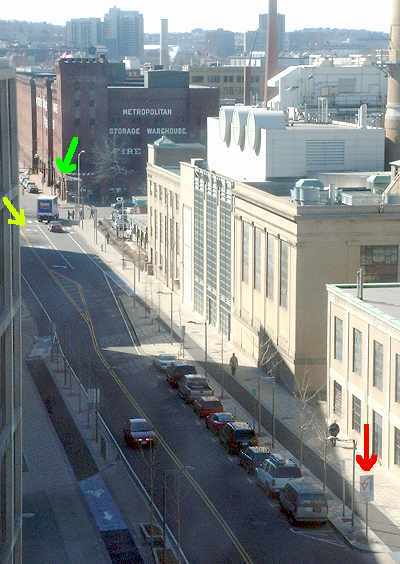
| The next photo shows how the sidepath and bike lane are concealed from motorists' view. |
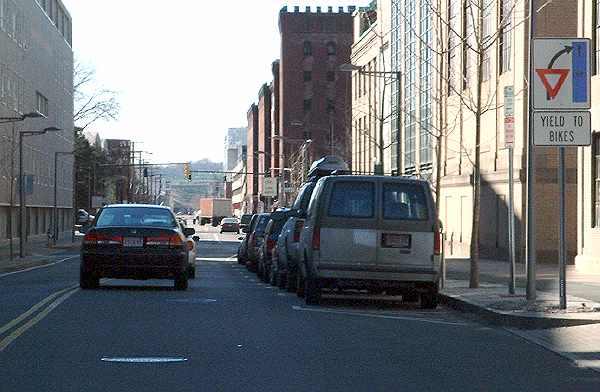
| Additional signs nearer the intersection reinforce the unlawful instruction by the
first sign. The sign shown in the upper right corner of the photo below indicates the
destinations for the ordinary travel lanes while failing to mention the bike lane. The
sign that follows (next to the fire hydrant in the photo) indicates that the right lane is
for bicycles only, in conflict with the traffic law. Then, closer to the corner are two signs for a bus stop. I tip my helmet to the MBTA. As the photo shows, its drivers have been correctly trained to stop close to the curb, ignoring the bike lane sign, so bicyclists won't body-check passengers getting on and off the bus. |
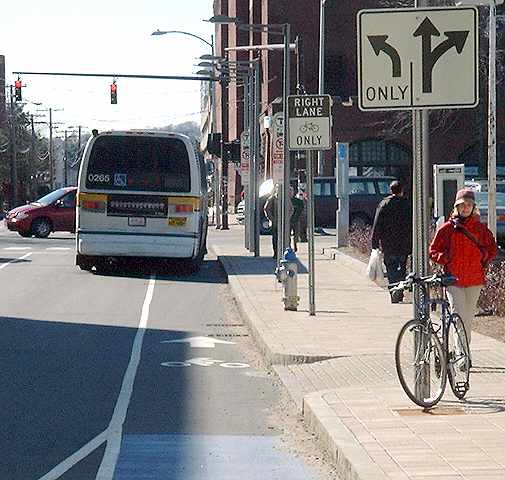
| If you click the Next>> link below, you can see a photo sequence that begins a few seconds later. As the bus pulls away, a bicyclist riding in the bike lane and catching up with motor vehicles is trapped to the right of a Honda mini-SUV turning right from the left lane. This situation is typical of the slow traffic on Vassar Street. As the bus pulls away, also note the semitrailer truck past the intersection, parked and unloading. The truck blocks the second lane, while a parked car blocks the curb lane. There will be more about the unloading trucks on another page. |
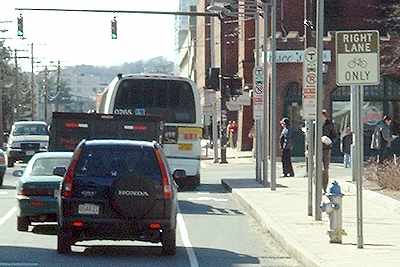
| Now let's use a bit of digital magic to put the bicyclist and motorist through
the intersection correctly. In the sequence below, the motorist merges to the right,
as required by law and in spite of the sign. The bicyclist scans to the left and merges
left to overtake the right-turning traffic. Negotiating a merge is very easy when
bicyclists travel as fast as the motor traffic, or faster, as is typical on Vassar Street. Ghost images of the bicyclist and the motor vehicle in the incorrect positions are shown for comparison's sake. |

The risk to avoidIn most of the notorious bicycle crashes in the Boston area in recent years involving adult bicyclists, the bicyclist was overtaking on the right or stuck by a right-turning vehicle:
|
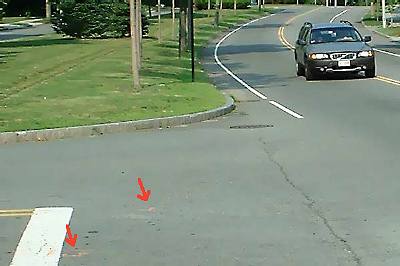 |
William O'Brien was traveling toward the camera next to a line of stopped vehicles, and the minivan that he struck was traveling from right to left in the photo. The red arrows point to markings locating the back end of the minivan where it stopped. Let's not encourage bicyclists to overtake on the right. |
| The classic Cross-Fisher study of car-bike collisions shows the motorist left turn across a bicyclist's path to be the #1 cause of car-bike crashes, and the motorist right turn to be the #2 cause. With a record like this, it hardly seems prudent to design streets intentionally to encourage bicyclists to overtake on the right, or motorists to turn right from the left lane. |
[Table of Contents]
[Previous: Snowed under]
[Next: One way? No way!]